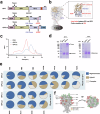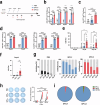Structure-guided design of a prefusion GPC trimer induces neutralizing responses against LASV
- PMID: 39987102
- PMCID: PMC11847010
- DOI: 10.1038/s41541-025-01090-4
Structure-guided design of a prefusion GPC trimer induces neutralizing responses against LASV
Abstract
Lassa virus (LASV) belongs to the Arenaviridae family and causes severe hemorrhagic fever in humans. Although many vaccine candidates for Lassa fever exist, no vaccines have been approved for clinical use currently. The precursor glycoprotein complex (GPC), which is expressed as a trimer on the viral surface, is the main target for vaccine development. However, it has been a significant challenge to elicit effective neutralizing antibodies against LASV. In this study, we designed and produced a prefusion GPC trimer antigen of LASV, named GPCv2. Based on the structural information of GPC, we made modifications by replacing the amino acid at position 328 with proline and appending the trimerization domain. This resulted in a highly expressed prefusion trimeric form of GPCv2 that retained important conformational epitopes and stimulated higher levels of neutralizing antibodies. Moreover, vaccination with GPCv2 protected mice from LASV pseudovirus challenge. Additionally, immune repertoire sequencing showed that the induced immune clones in the trimeric group were more convergent and has its own unique V-J pairing bias compared with monomeric group. These findings demonstrate the potential of GPCv2 as a promising candidate antigen for an effective vaccine against LASV.
© 2025. The Author(s).
Conflict of interest statement
Competing interests: The authors declare no competing interests.
Figures





Similar articles
-
A Lassa Fever Live-Attenuated Vaccine Based on Codon Deoptimization of the Viral Glycoprotein Gene.mBio. 2020 Feb 25;11(1):e00039-20. doi: 10.1128/mBio.00039-20. mBio. 2020. PMID: 32098811 Free PMC article.
-
Structural conservation of Lassa virus glycoproteins and recognition by neutralizing antibodies.Cell Rep. 2023 May 30;42(5):112524. doi: 10.1016/j.celrep.2023.112524. Epub 2023 May 18. Cell Rep. 2023. PMID: 37209096 Free PMC article.
-
Cleavage-intermediate Lassa virus trimer elicits neutralizing responses, identifies neutralizing nanobodies, and reveals an apex-situated site-of-vulnerability.Nat Commun. 2024 Jan 4;15(1):285. doi: 10.1038/s41467-023-44534-y. Nat Commun. 2024. PMID: 38177144 Free PMC article.
-
Inter-Lineage Variation of Lassa Virus Glycoprotein Epitopes: A Challenge to Lassa Virus Vaccine Development.Viruses. 2020 Mar 31;12(4):386. doi: 10.3390/v12040386. Viruses. 2020. PMID: 32244402 Free PMC article. Review.
-
Baseline mapping of Lassa fever virology, epidemiology and vaccine research and development.NPJ Vaccines. 2018 Mar 20;3:11. doi: 10.1038/s41541-018-0049-5. eCollection 2018. NPJ Vaccines. 2018. PMID: 29581897 Free PMC article. Review.
Cited by
-
Deep mutational scanning of rabies glycoprotein defines mutational constraint and antibody-escape mutations.Cell Host Microbe. 2025 Jun 11;33(6):988-1003.e10. doi: 10.1016/j.chom.2025.04.018. Epub 2025 May 20. Cell Host Microbe. 2025. PMID: 40398416
References
-
- Moore, K. A. et al. Lassa fever research priorities: towards effective medical countermeasures by the end of the decade. Lancet Infect. Dis.11, e696–e706 (2024). - PubMed
-
- CEPI. Preparing for lassa vaccine trials with targeted epidemiology studies. Epidemic Preparedness Innovations (CEPI) (2020).
-
- Thielebein, A. et al. Virus persistence after recovery from acute Lassa fever in Nigeria: a 2-year interim analysis of a prospective longitudinal cohort study. Lancet Microbe3, e32–e40 (2022). - PubMed
Grants and funding
LinkOut - more resources
Full Text Sources

